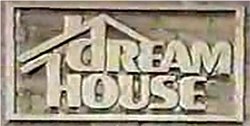Dream House (game show)
| Dream House | |
|---|---|
 |
|
| Created by | Don Reid |
| Directed by | Alan Mifelow (1968–70) Dick Schneider (1968–70) Jeff Goldstein (1983–84) |
| Creative director(s) | Charles Colarusso (Creative Consultant, 1983) Richard Reid (Creative Consultant, 1983–84) |
| Presented by |
Mike Darrow (1968–70) Bob Eubanks (1983–84) |
| Narrated by |
Chet Gould (1968–70) Johnny Gilbert (1983–84) |
| Composer(s) | Don Reid (1968–70) Edd Kalehoff (1983–84) |
| Country of origin |
|
| Production | |
| Executive producer(s) | Don Reid Bob Ruben (1983) Bob Synes (1984) |
| Producer(s) |
Ron Greenberg (1968–70) Ron Kweskin (1968–70) George Vosburgh (1968–70) Bob Synes (1983) Lee Goldstein (1983) Peter Noah (1983) |
| Location(s) |
NBC Studios Burbank, California (1983–84) |
| Running time | approx. 26 minutes |
| Production company(s) | Don Reid Productions (1968–70, 1983–84) ABC Productions (1968–70) Group W Productions (1983–84) Lorimar Television (1984) |
| Release | |
| Original network | ABC Daytime (1968–70) ABC Primetime (1968) NBC (1983–84) |
| Original release | March 27–September 19, 1968 (Primetime) April 1, 1968–January 2, 1970 April 4, 1983 – June 29, 1984 |
Dream House is an American game show that saw contestants competing to win, as the title of the show indicates, a new house. The show originally premiered in primetime on ABC on March 27, 1968, with a daytime edition premiering on April 1, 1968. The primetime series aired weekly until September 19, 1968 and the daytime series aired daily until January 2, 1970. The daytime series was revived for NBC's daytime schedule and premiered on April 4, 1983, running until June 29, 1984.
The original Dream House was hosted by Mike Darow with Chet Gould announcing.Bob Eubanks hosted the revival series with Johnny Gilbert as announcer. The ABC version was recorded in New York City, while the NBC run was staged at the network's studios in Burbank, California.
The first format involved two couples competing in a game of quick recall. The first contestant to buzz-in answered and received five points for a correct response. If the contestant was wrong, however, the other couple could try to answer for ten points. When a contestant gave a correct answer, he or she was locked out of the next question.
Two minutes before the end of the game, which lasted from four to five minutes, the point values doubled, and at the end was the "Catch-Up Round" in which the team that was trailing could choose one last question from 10 to 50 points (if they answered correctly, the other couple got one last shot). The winning couple won a room of furniture.
Couples who won seven rooms of furniture on the daytime version (four on the 1968 primetime version) won their choice of either a new house (worth over $40,000, plus $7,000 to purchase land) or $20,000 in cash.
Beginning in 1969, three couples competed in the first round in which the first couple to buzz-in with a correct answer scored five points. A wrong answer, however, gave the other couples a chance to score ten points. Only during that first round would all contestants be allowed to buzz-in on all questions. The points were doubled during the last two minutes of the round. The two highest-scoring couples advanced to the next round, played exactly the same as the previous two-couple format. Five-time champions were offered an airplane in lieu of attempting to win two more games.
Two teams of two (usually married couples), one of them a returning champion, competed to win a house worth approximately $100,000.
...
Wikipedia
